2016 California Standards for Accessible Design Pocket Guide - Eff. Jan. 1, 2017
11B-505 Handrails.
11B-505.1 General.
Handrails provided along walking surfaces complying with Section 11B-403, required at ramps complying with Section 11B-405, and required at stairs complying with Section 11B-504 shall comply with Section 11B-505.
[2010 ADAS] Advisory 505.1 General. Handrails are required on ramp runs with a rise greater than 6 inches (150 mm) (see 405.8) and on certain stairways (see 504). Handrails are not required on walking surfaces with running slopes less than 1:20. However, handrails are required to comply with 505 when they are provided on walking surfaces with running slopes less than 1:20 (see 403.6). Sections 505.2, 505.3, and 505.10 do not apply to handrails provided on walking surfaces with running slopes less than 1:20 as these sections only reference requirements for ramps and stairs.
11B-505.2 Where required.
Handrails shall be provided on both sides of stairs and ramps.
Exceptions:
1. In assembly areas, handrails shall not be required on both sides of aisle ramps where a handrail is provided at either side or within the aisle width.
2. Curb ramps do not require handrails.
3. At door landings, handrails are not required when the ramp run is less than 6 inches (152 mm) in rise or 72 inches (1829 mm) in length.
11B-505.2.1 Orientation.
The orientation of at least one handrail shall be in the direction of the stair run, perpendicular to the direction of the stair nosing, and shall not reduce the minimum required width of the stair.
11B-505.3 Continuity.
Handrails shall be continuous within the full length of each stair flight or ramp run. Inside handrails on switchback or dogleg stairs and ramps shall be continuous between flights or runs.
Exception: In assembly areas, ramp handrails adjacent to seating or within the aisle width shall not be required to be continuous in aisles serving seating.
[2010 ADAS] EXCEPTION: In assembly areas, handrails on ramps shall not be required to be continuous in aisles serving seating.
11B-505.4 Height.
Top of gripping surfaces of handrails shall be 34 inches (864 mm) minimum and 38 inches (965 mm) maximum vertically above walking surfaces, stair nosings, and ramp surfaces. Handrails shall be at a consistent height above walking surfaces, stair nosings, and ramp surfaces.
[2010 ADAS] Advisory 505.4 Height. The requirements for stair and ramp handrails in this document are for adults. When children are the principal users in a building or facility (e.g., elementary schools), a second set of handrails at an appropriate height can assist them and aid in preventing accidents. A maximum height of 28 inches (710 mm) measured to the top of the gripping surface from the ramp surface or stair nosing is recommended for handrails designed for children. Sufficient vertical clearance between upper and lower handrails, 9 inches (230 mm) minimum, should be provided to help prevent entrapment.
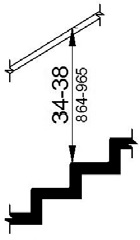
(a)
stairs
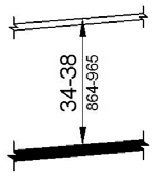
(b)
ramps
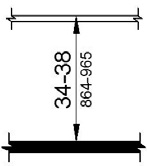
(c)
walking surfaces
FIGURE 11B-505.4
HANDRAIL HEIGHT
11B-505.5 Clearance.
Clearance between handrail gripping surfaces and adjacent surfaces shall be 1½ inches (38 mm) minimum. Handrails may be located in a recess if the recess is 3 inches (76 mm) maximum deep and 18 inches (457 mm) minimum clear above the top of the handrail.
[2010 ADAS] 505.5 Clearance. Clearance between handrail gripping surfaces and adjacent surfaces shall be 1½ inches (38 mm) minimum.
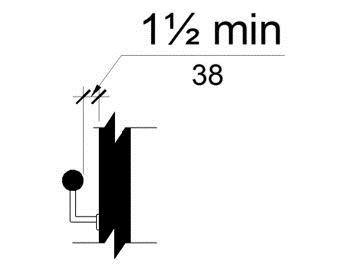
FIGURE 11B-505.5
HANDRAIL CLEARANCE
11B-505.6 Gripping surface.
Handrail gripping surfaces shall be continuous along their length and shall not be obstructed along their tops or sides. The bottoms of handrail gripping surfaces shall not be obstructed for more than 20 percent of their length. Where provided, horizontal projections shall occur 1½ inches (38 mm) minimum below the bottom of the handrail gripping surface.
Exceptions:
1. Where handrails are provided along walking surfaces with slopes not steeper than 1:20, the bottoms of handrail gripping surfaces shall be permitted to be obstructed along their entire length where they are integral to crash rails or bumper guards.
2. The distance between horizontal projections and the bottom of the gripping surface shall be permitted to be reduced by 1/8 inch (3.2 mm) for each ½ inch (12.7 mm) of additional handrail perimeter dimension that exceeds 4 inches (102 mm).
[2010 ADAS] Advisory 505.6 Gripping Surface. People with disabilities, older people, and others benefit from continuous gripping surfaces that permit users to reach the fingers outward or downward to grasp the handrail, particularly as the user senses a loss of equilibrium or begins to fall.
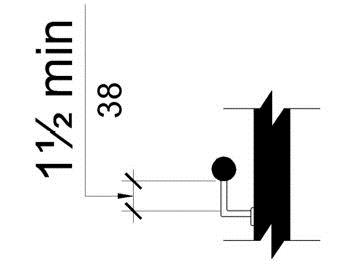
FIGURE 11B-505.6
HORIZONTAL PROJECTIONS BELOW GRIPPING SURFACE
11B-505.7 Cross section.
Handrail gripping surfaces shall have a cross section complying with Section 11B-505.7.1 or 11B-505.7.2.
11B-505.7.1 Circular cross section.
Handrail gripping surfaces with a circular cross section shall have an outside diameter of 1¼ inches (32 mm) minimum and 2 inches (51 mm) maximum.
11B-505.7.2 Non-circular cross sections.
Handrail gripping surfaces with a non-circular cross section shall have a perimeter dimension of 4 inches (102 mm) minimum and 6¼ inches (159 mm) maximum, and a cross-section dimension of 2¼ inches (57 mm) maximum.
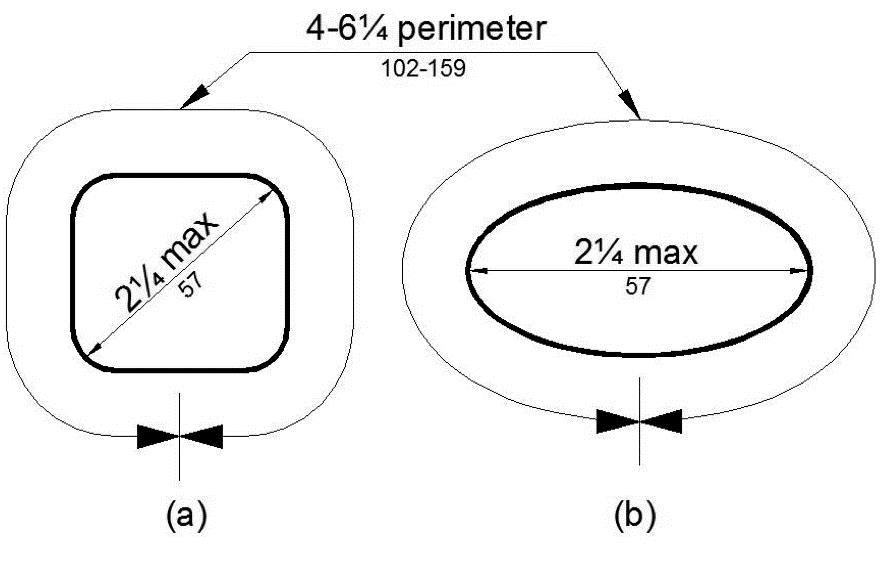
FIGURE 11B-505.7.2
HANDRAIL NON-CIRCULAR CROSS SECTION
11B-505.8 Surfaces.
Handrail gripping surfaces and any surfaces adjacent to them shall be free of sharp or abrasive elements and shall have rounded edges.
11B-505.9 Fittings.
Handrails shall not rotate within their fittings.
11B-505.10 Handrail extensions.
Handrail gripping surfaces shall extend beyond and in the same direction of stair flights and ramp runs in accordance with Section 11B-505.10.
Exceptions:
1. Extensions shall not be required for continuous handrails at the inside turn of switchback or dogleg stairs and ramps.
2. In assembly areas, extensions shall not be required for ramp handrails in aisles serving seating where the handrails are discontinuous to provide access to seating and to permit crossovers within aisles.
3. In alterations, where the extension of the handrail in the direction of stair flight or ramp run would create a hazard, the extension of the handrail may be turned 90 degrees from the direction of stair flight or ramp run.
[2010 ADAS] 3. In alterations, full extensions of handrails shall not be required where such extensions would be hazardous due to plan configuration.
ETA Editor's Note
CBC 11B-505.10 Exception 3 is more stringent than 2010 ADAS, which allows the handrail extensions to be eliminated in alterations where they would be hazardous. Handrail extensions are never permitted to turn 90 degrees at new stairs or new ramps, either by CBC or ADAS, except at continuous inside handrails (per Exception 1).
11B-505.10.1 Top and bottom extension at ramps.
Ramp handrails shall extend horizontally above the landing for 12 inches (305 mm) minimum beyond the top and bottom of ramp runs. Extensions shall return to a wall, guard, or the landing surface, or shall be continuous to the handrail of an adjacent ramp run.
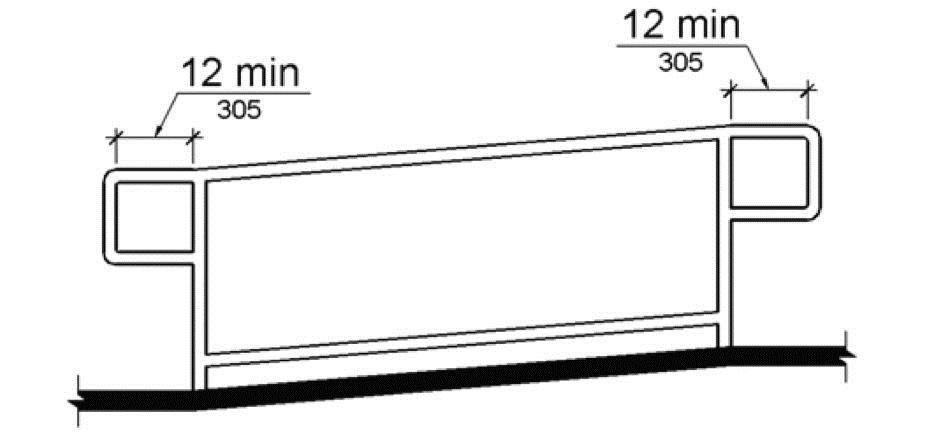
FIGURE 11B-505.10.1
TOP AND BOTTOM HANDRAIL EXTENSION AT RAMPS
11B-505.10.2 Top extension at stairs.
At the top of a stair flight, handrails shall extend horizontally above the landing for 12 inches (305 mm) minimum beginning directly above the first riser nosing. Extensions shall return to a wall, guard, or the landing surface, or shall be continuous to the handrail of an adjacent stair flight.
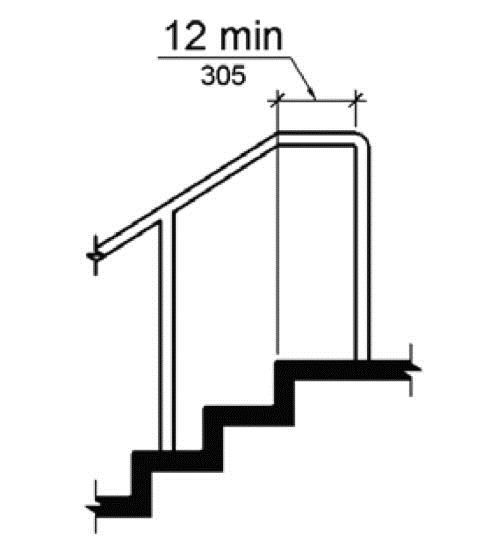
FIGURE 11B-505.10.2
TOP HANDRAIL EXTENSION AT STAIRS
11B-505.10.3 Bottom extension at stairs.
At the bottom of a stair flight, handrails shall extend at the slope of the stair flight for a horizontal distance equal to one tread depth beyond the last riser nosing. The horizontal extension of a handrail shall be 12 inches (305 mm) long minimum and a height equal to that of the sloping portion of the handrail as measured above the stair nosings. Extension shall return to a wall, guard, or the landing surface, or shall be continuous to the handrail of an adjacent stair flight.
[2010 ADAS] 505.10.3 Bottom Extension at Stairs. At the bottom of a stair flight, handrails shall extend at the slope of the stair flight for a horizontal distance at least equal to one tread depth beyond the last riser nosing. Extension shall return to a wall, guard, or the landing surface, or shall be continuous to the handrail of an adjacent stair flight.
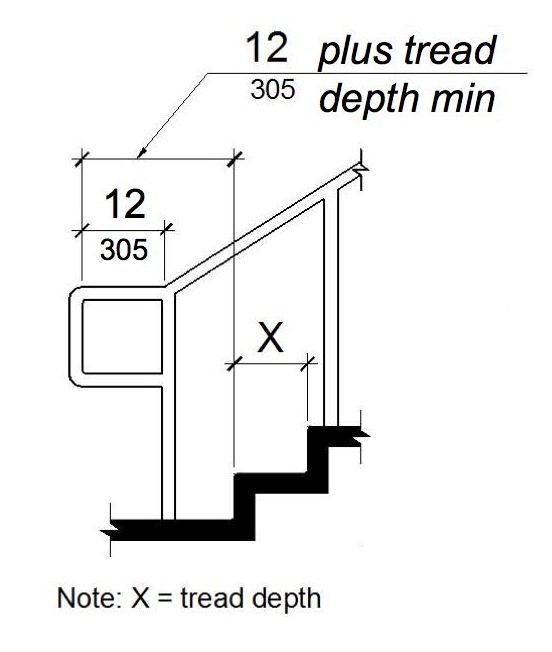
FIGURE 11B-505.10.3 ‡‡
BOTTOM HANDRAIL EXTENSION AT STAIRS
ETA Editor's Note
The CBC 11B-505.10.3 requirement for bottom handrail extension at stairs is more stringent than 2010 ADAS, which was revised from 1991 ADAAG.

User Comments/Questions
Add Comment/Question